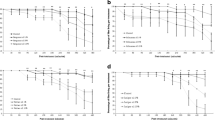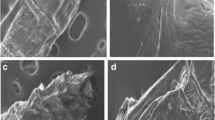Abstract
In present study, the essential oils such as Mentha piperita (mentha oil, M.O), Cymbopogan citratus (lemongrass oil, LG.O), Citrus sinensis (orange oil, O.O), and Eucalyptus globulus (eucalyptus oil, E.O) were evaluated for repellency against housefly (Musca domestica) in a specially designed chamber. Further, to study any synergistic effect, essential oil combinations, i.e., M.O + LG.O, M.O + O.O, and M.O + E.O, were screened at 50:50 and 70:30 ratios. The results showed superior repellency of mentha and mentha + lemongrass (70:30) with RC95 value of 0.009 μl/cm3. The other oils and combinations showed higher values of RC95 (0.010–0.041 μl/cm3). The order of repellency was observed to be mentha = mentha + lemongrass (70:30) > mentha + lemongrass (50:50) = lemongrass = mentha + orange (50:50) = mentha + orange (70:30) > mentha + eucalyptus (70:30) > orange > mentha + eucalyptus (50:50) > eucalyptus. Chemical composition of selected essential oils indicated various monoterpenes as active components for efficient repellency. The essential oil of mentha marked the presence of menthol (38%) and menthone (27%) in major fractions, whereas citral (49%) was found dominating in lemongrass oil. Eucalyptus and orange oils showed the presence of 1,8-cineole (85%), and limonene (87%), respectively, as major components of oils. Further, monoterpenes (menthol and limonene) were also evaluated for repellency against housefly. The data showed 90 ± 5 and 60 ± 5% repellency from menthol and limonene, respectively, after 1 h, indicating the vital role of monoterpenes in overall efficacy of essential oil.

Similar content being viewed by others
References
Abbott WS (1925) A method of computing the effectiveness of an insecticide. J Econ Entomol 18(2):265–267
Andoğan BC, Baydar H, Kaya S, Demirci M, Özbaşar D, Mumcu E (2002) Antimicrobial activity and chemical composition of some essential oils. Arch Pharm Res 25(6):860–864
Ansari MA, Vasudevan P, Tandon M, Razdan RK (2000) Larvicidal and mosquito repellent action of peppermint (Mentha piperita) oil. Bioresour Technol 71(3):267–271
Azar AP, Nekoei M, Larijani K, Bahraminasab S (2011) Chemical composition of the essential oils of Citrus sinensis cv. valencia and a quantitative structure-retention relationship study for the prediction of retention indices by multiple linear regression. J Serb Chem Soc 76(12):627–1637
Bekele J, Hassanali A (2001) Blend effects in the toxicity of the essential oil constituents of Ocimum kilimandscharicum and Ocimum kenyense (Labiateae) on two post-harvest insect pests. Phytochemistry 57(3):385–391
Cavalcanti ES, Morais SM, Lima MA, Santana EW (2004) Larvicidal activity of essential oils from Brazilian plants against Aedes aegypti L. Mem Inst Oswaldo Cruz 99(5):541–544
Chauhan N, Kumar P, Mishra S, Verma S, Malik A, Sharma S (2015) Insecticidal activity of Jatropha curcas extracts against housefly, Musca domestica. Environ Sci Pollut Res 22(19):14793–14800
Chauhan N, Malik A, Sharma S, Dhiman RC (2016) Larvicidal potential of essential oils against Musca domestica and Anopheles stephensi. Parasitol Res 115(6):2223–2231
Cimanga K, Kambu K, Tona L, Apers S, De Bruyne T, Hermans N, Totté J, Pieters L, Vlietinck AJ (2002) Correlation between chemical composition and antibacterial activity of essential oils of some aromatic medicinal plants growing in the Democratic Republic of Congo. J Ethnopharmacol 79(2):213–220
Erler F, Ulug I, Yalcinkaya B (2006) Repellent activity of five essential oils against Culex pipiens. Fitoterapia 77(7):491–494
Geden CJ (2012) Status of biopesticides for control of house flies. J Biopestic 15:1–1
Gillij YG, Gleiser RM, Zygadlo JA (2008) Mosquito repellent activity of essential oils of aromatic plants growing in Argentina. Bioresour Technol 99(7):2507–2515
Gul P (1994) Seasonal variation of oil and menthol content in Mentha arvensis Linn. Pak J For 44:16–20
Jaenson TG, Garboui S, Pålsson K (2006) Repellency of oils of lemon eucalyptus, geranium, and lavender and the mosquito repellent MyggA natural to Ixodes ricinus (Acari: Ixodidae) in the laboratory and field. J Med Entomol 43(4):731–736
Javed S, Javaid A, Nawaz S, Saeed MK, Mahmood Z, Siddiqui SZ, Ahmad R (2014) Phytochemistry, GC-MS analysis, antioxidant and antimicrobial potential of essential oil from five citrus species. J Agric Sci 6(3):201
Jiang Z, Akhtar Y, Bradbury R, Zhang X, Isman MB (2009) Comparative toxicity of essential oils of Litsea pungens and Litsea cubeba and blends of their major constituents against the cabbage looper, Trichoplusia ni. J Agric Food Chem 57(11):4833–4837
Jimenez-Carmona MM, de Castro ML (1999) Isolation of eucalyptus essential oil for GC-MS analysis by extraction with subcritical water. Chromatographia 50(9–10):578–582
Krause MS (2010) Could plant pathogens and pests become resistant to biopesticides. Technical Bulletin, Bioworks
Kumar P, Mishra S, Malik A, Satya S (2011a) Repellent, larvicidal and pupicidal properties of essential oils and their formulations against the housefly, Musca domestica. Med Vet Entomol 25(3):302–310
Kumar S, Wahab N, Warikoo R (2011b) Bioefficacy of Mentha piperita essential oil against dengue fever mosquito Aedes aegypti L. Asian Pac J Trop Biomed 1(2):85–88
Kumar P, Mishra S, Malik A, Satya S (2012a) Insecticidal evaluation of essential oils of Citrus sinensis L. (Myrtales: Myrtaceae) against housefly, Musca domestica L. (Diptera: Muscidae). Parasitol Res 110(5):1929–1936
Kumar P, Mishra S, Malik A, Satya S (2012b) Compositional analysis and insecticidal activity of Eucalyptus globulus (family: Myrtaceae) essential oil against housefly (Musca domestica). Acta Trop 122(2):212–218
Kumar P, Mishra S, Malik A, Satya S (2012c) Efficacy of Mentha × piperita and Mentha citrata essential oils against housefly, Musca domestica L. Ind Crop Prod 39:106–112
Kumar P, Mishra S, Malik A, Satya S (2013) Housefly (Musca domestica L.) control potential of Cymbopogon citratus Stapf.(Poales: Poaceae) essential oil and monoterpenes (citral and 1, 8-cineole). Parasitol Res 112(1):69–76
Kumar P, Mishra S, Malik A, Satya S (2014) Biocontrol potential of essential oil monoterpenes against housefly, Musca domestica (Diptera: Muscidae). Ecotoxicol Environ Saf 100:1–6
Liu CH, Mishra AK, Tan RX, Tang C, Yang H, Shen YF (2006) Repellent and insecticidal activities of essential oils from Artemisia princeps and Cinnamomum camphora and their effect on seed germination of wheat and broad bean. Bioresour Technol 97(15):1969–1973
Maciel MV, Morais SM, Bevilaqua CM, Silva RA, Barros RS, Sousa RN, Sousa LC, Brito ES, Souza-Neto MA (2010) Chemical composition of Eucalyptus spp. essential oils and their insecticidal effects on Lutzomyia longipalpis. Vet Parasitol 167(1):1–7
Maffei M, Mucciarelli M, Scannerini S (1994) Essential oils from Achillea species of different geographic origin. Biochem Syst Ecol 22(7):679–687
Malik A, Singh N, Satya S (2007) House fly (Musca domestica): a review of control strategies for a challenging pest. J Environ Sci Health B 42(4):453–469
Morey RA, Khandagle AJ (2012) Bioefficacy of essential oils of medicinal plants against housefly, Musca domestica L. Parasitol Res 111(4):1799–1805
Moufida S, Marzouk B (2003) Biochemical characterization of blood orange, sweet orange, lemon, bergamot and bitter orange. Phytochemistry 62(8):1283–1289
Nerio LS, Olivero-Verbel J, Stashenko E (2010) Repellent activity of essential oils: a review. Bioresour Technol 101(1):372–378
Palacios SM, Bertoni A, Rossi Y, Santander R, Urzúa A (2009) Efficacy of essential oils from edible plants as insecticides against the house fly, Musca domestica L. Molecules 14(5):1938–1947
Pavela R (2008) Insecticidal properties of several essential oils on the house fly (Musca domestica L.) Phytother Res 22(2):274–278
Rani PU, Osmani Z (1980) Insecticidal, fumigant and repellent properties of citral against housefly Musca domestica nebulo (Fabr.) Pesticides 14(12):6–8
Sacchetti G, Maietti S, Muzzoli M, Scaglianti M, Manfredini S, Radice M, Bruni R (2005) Comparative evaluation of 11 essential oils of different origin as functional antioxidants, antiradicals and antimicrobials in foods. Food Chem 91(4):621–632
Singh V, Mishra N, Awasthi G, Dash AP, Das A (2009) Why is it important to study malaria epidemiology in India? Trends Parasitol 25(10):452–457
Sinthusiri J, Soonwera M (2013) Efficacy of herbal essential oils as insecticides against the housefly, Musca domestica L. Southeast Asian J Trop Med Public Health 44(2):188
Soković MD, Vukojević J, Marin PD, Brkić DD, Vajs V, Van Griensven LJ (2009) Chemical composition of essential oils of thymus and mentha species and their antifungal activities. Molecules 14(1):238–249
Soonwera M, Sinthusiri J (2014) Thai Essential oils as botanical insecticide against house fly (Musca domestica L.). International Conference on Agricultural, Ecological and Medical Sciences, Bali, pp 6–7
SPSS (2008) Statistical product and service solution. System user’s guide, version 17.5
Srinivasan R, Jambulingam P, Gunasekaran K, Boopathidoss PS (2008) Tolerance of house fly, Musca domestica L.(Diptera: Muscidae) to dichlorvos (76% EC) an insecticide used for fly control in the tsunami-hit coastal villages of southern India. Acta Trop 105(2):187–190
Sritabutra D, Soonwera M, Waltanachanobon S, Poungjai S (2011) Evaluation of herbal essential oil as repellents against Aedes aegypti (L.) and Anopheles dirus Peyton and Harrion. Asian Pac J Trop Biomed 1(1):S124–S128
Tawatsin A, Wratten SD, Scott RR, Thavara U, Techadamrongsin Y (2001) Repellency of volatile oils from plants against three mosquito vectors. J Vector Ecol 26:76–82
Toloza AC, Lucia A, Zerba E, Masuh H, Picollo MI (2008) Interspecific hybridization of Eucalyptus as a potential tool to improve the bioactivity of essential oils against permethrin-resistant head lice from Argentina. Bioresour Technol 99(15):7341–7347
Trongtokit Y, Rongsriyam Y, Komalamisra N, Apiwathnasorn C (2005) Comparative repellency of 38 essential oils against mosquito bites. Phytother Res 19(4):303–309
Tyagi AK, Malik A (2011) Antimicrobial potential and chemical composition of Mentha piperita oil in liquid and vapour phase against food spoiling microorganisms. Food Control 22(11):1707–1714
Tyagi AK, Prasad S (2015) Volatile phytochemicals: potential role in food safety and preservation. Air Water Borne Dis 10(4172):2167–7719
Verzera A, Trozzi A, Dugo G, Di Bella G, Cotroneo A (2004) Biological lemon and sweet orange essential oil composition. Flavour Fragr J 19(6):544–548
Acknowledgements
The authors are thankful for the technical support provided by Mr. Ajai Kumar (AIRF JNU, India) for GC-MS analysis. We acknowledge the experimental assistance provided by Mr. Satendra Kumar, Mr. Vinod Kumar, and Mr. Sabal Singh (IIT Delhi, India).
Funding
Financial support provided by UGC (RGNF) is gratefully acknowledged.
Author information
Authors and Affiliations
Corresponding author
Ethics declarations
The present research work complies with all the ethical guidelines.
Conflict of interest
The authors declare that they have no conflict of interest.
Additional information
Responsible editor: Philippe Garrigues
Rights and permissions
About this article
Cite this article
Chauhan, N., Malik, A. & Sharma, S. Repellency potential of essential oils against housefly, Musca domestica L.. Environ Sci Pollut Res 25, 4707–4714 (2018). https://doi.org/10.1007/s11356-017-0363-x
Received:
Accepted:
Published:
Issue Date:
DOI: https://doi.org/10.1007/s11356-017-0363-x




